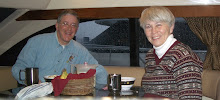
Yesterday afternoon, we took a tour through town and sadly found the museum was closed. However, we saw the hull of a ship from the war of 1812, the Ticonderoga. We also found a grocery store. We also watched some boys fishing from the bridge over the lock and watched them snag a 3 foot fresh water drum caught with a line and

then hauled in with a basket. They said it was fun to catch but not to eat.
Last night we had dinner at Finch and Chubb, fine dining just above the marina and the location of the lumber mill that cut the timber for our first Navy boats. The restaurant had

wonderful dark hardwood floors and dark tables with the windows overlooking the water framed in antique lace. We had a great dinner and watched the rain dancing on the water with lightening in the distance as the storm rolled through. Actually rain in the evening makes for great sleeping!
This morning Tom celebrated Fathers Day with sweet cards and gifts from his daughters stashed away from when the girls visited. After breakfast, we took our bikes into town to the Grace Baptist Church which was a small white wooden church started in 1985 and affiliated with the SBC. We got there early and discovered their adult Sunday School class meeting in the

Sanctuary so we joined in for their study from Proverbs 23. As the worship service started, their young pastor named Daniel, from Arkansas, played his guitar for the praise hymn singing. In his message, he made an interesting comment. He said he saw a lot of turtles in the congregation. To explain, he said if you come along and you find a turtle on a fence post, you know he didn’t get there by himself. God has put you where you are and you need to figure out what you can do for Him there. The people were friendly and very surprised at our visit on our bikes from our boat in the marina.
After church we set off into the Champlain Narrows. This area, at the southwestern end of Lake Champlain, was flooded so that you could see water over the bank into the woods. Or

perhaps it is a year round swamp with trees growing in a few inches of water and acres of marsh grass snuggling up to the rocky cliffs near the banks. Someone at church told Tom that there was a fishing tournament today, and there were

certainly fishermen everywhere on the water this afternoon – hot shot young men on shiny fast bass boats as well as families with little children on pontoon boats, all fishing. We passed Fort Ticonderoga where we took the dinghy ashore. Our visit was short since , unfortunately, there was no path from the shore to the visitor center – only serious brambles. We came to a bush that I think was the crown of thorns and it marked the turning point of our trek inland.

It is about 30 miles to the main lake, and we anchored about half way at Crown Pointe for the night. It was warm enough that we took a swim in the lake before starting dinner. We were moored right under the 101 foot lighthouse built in honor of Samuel Champlain (discoverer of the lake), by a bronze statue by famous sculptor Auguste Rodin, and next to a concrete pier where local folks spent their evening fishing. On the other side was the expansive high Crown Pointe bridge.



 It was a deserted single room locked wooden building by the side of the train track. We waited with our luggage hoping the train would come and that it would actually stop. At 4:30 we called a 1-800 number on a poster there and was reassured that the train would be about 40 minutes late. Sure enough, the train came and it stopped!
It was a deserted single room locked wooden building by the side of the train track. We waited with our luggage hoping the train would come and that it would actually stop. At 4:30 we called a 1-800 number on a poster there and was reassured that the train would be about 40 minutes late. Sure enough, the train came and it stopped!  It was a deserted single room locked wooden building by the side of the train track. We waited with our luggage hoping the train would come and that it would actually stop. At 4:30 we called a 1-800 number on a poster there and was reassured that the train would be about 40 minutes late. Sure enough, the train came and it stopped!
It was a deserted single room locked wooden building by the side of the train track. We waited with our luggage hoping the train would come and that it would actually stop. At 4:30 we called a 1-800 number on a poster there and was reassured that the train would be about 40 minutes late. Sure enough, the train came and it stopped! 
















































